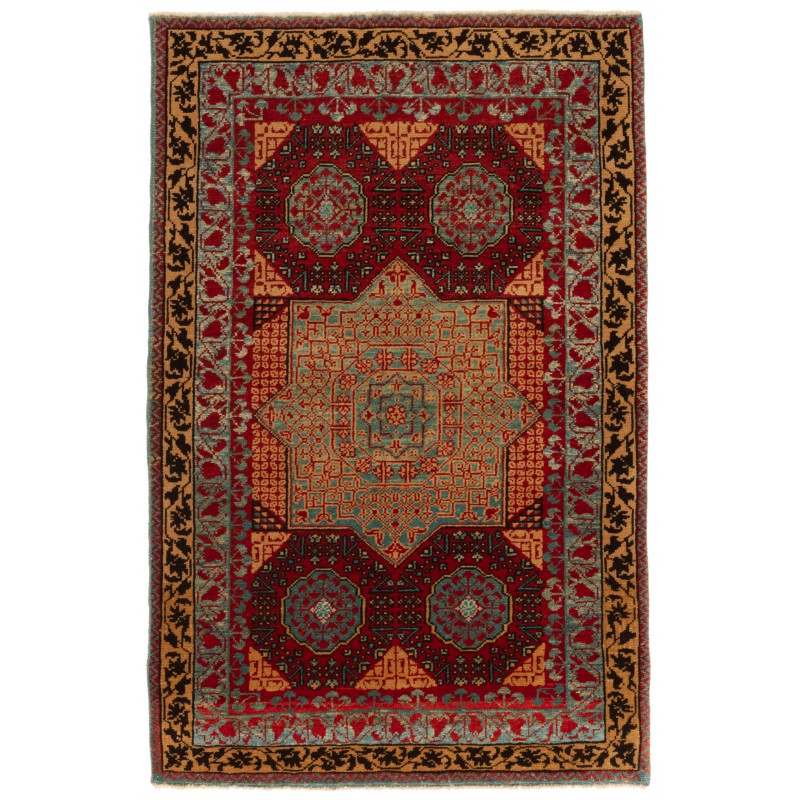
- Stock: 売り切れ
- Model: C40062
- サイズ: 72cm x 111cm
この絨毯の情報は、Angela Völkerによる著書『Die orientalischen Knüpfteppiche das MAK』(MAK – Museum of Applied Arts、Vienna: Böhlau、2001: 42–5)からのものです。この中央の星を持つ絨毯は、エジプトのカイロで活動したマムルークのスルタンによって16世紀初頭にデザインされました。この絨毯はオーストリアのウィーンにあるMAK – Museum of Applied Artsで展示されています。その印象的なサイズ、素材、デザインの品質から見ると、この絨毯は優れた宮廷工房の産物であり、おそらく最後のマムルーク朝の後期に作られたものです。使用されている多彩な色彩の量からは、約1500年ごろの早い時期の制作であることが示唆されます。葉のつると特徴的な傘のような葉で構成される繊細な植物模様のボーダーは、後期の時期を指すものです。1517年にオスマン帝国がマムルーク帝国を征服しましたが、カイロのカーペット工房はマムルーク様式の作品を16世紀中ごろまで製作し続けました。
カイロで製作された初期の絨毯を読み解くことは、まったく異なる課題のセットを提供します。カイロの絨毯は、その限られた色彩パレット、対称的な結び目、異例のS-撚りのウールの構造(イスラム世界のほとんどの地域ではZ-撚りのウールが一般的です)で特徴付けられ、1517年のオスマン帝国によるマムルーク帝国の征服後にデザイン上の急激な変化を経験しました。シモネッティ絨毯は征服後に織られたものですが、マムルークの「古い」15世紀のスタイルを示しています。この絨毯は細長く、エジプトの標準的なローラービーム織機で織られ、さまざまな長さの絨毯を生産することができました。デザイン上の五つの主要な焦点領域がA-B-C-B-Aのパターンで配置されており、最初と最後、および第二と第四の領域がペアになっており、中央がユニークです。これらの五つの焦点領域をメダリオンと呼ぶことができますが、レイアウトとディテールの両方で幾何学的であり、そのスタイル(織られた実際の日付とは異なり)はメダリオン形式が生まれる前のカーペットデザインの革命を先取りしています。マムルークの絨毯のデザインと色彩は、赤、青、緑、そして時には黄色といった昆虫由来の特異な組み合わせで、ほとんど無染色の白をほとんど含まない、早期近代市場での認識可能なブランドの創造を試みたものと考えられます。特にヨーロッパでは、このようなマムルークの絨毯は、繊細な彩色、非常に詳細なデザイン、小さな複雑な幾何学的なモチーフのモザイク状の配置などから、アナトリアのより粗く織られ、鮮やかな色彩のカーペット(例えばウシャクのメダリオン絨毯)とは異なる魅力的な選択肢となりました。伝統的な幾何学的なマムルークのデザインでのカーペットの織りは、おそらく17世紀半ばまで続けられたと推測されますが、16世紀中頃を境に、カイロの織り手たちは伝統的なマムルークの素材、技法、色彩を使用しながら、イスタンブールのオスマンスルタンの宮廷で生み出された最新のスタイルを反映したまったく新しいタイプのカーペットを作り始めました。この絨毯のデザインは、私たちのデザイナーによって解釈され、鮮やかな色彩が使用されています。
The source of the rug comes from the book Völker, Angela, Die orientalischen Knüpfteppiche das MAK, Vienna: Böhlau, 2001: 42–5. This rug with the central star was designed in the early 16th-century rug by Mamluk Sultane of Cairo, Egypt. It is exhibited at MAK – Museum of Applied Arts, Vienna Austria. As its impressive size, materials, and design quality suggest, the carpet is a product of an accomplished court workshop and likely dates from the late period of the last Mamluk dynasty. The quantity of the colors used speaks for an earlier date around 1500; the delicate vegetal border with leaf tendrils and the characteristic umbrella leaves rather point to a later date. In 1517, the Ottomans conquered the Mamluk Empire, but Cairo’s carpet workshops still produced pieces until the mid-16th century in a post-Mamluk style.
Attempting to read early carpets produced in workshops in Cairo provides an entirely different set of challenges. Cairene carpets, distinguished by their limited color palette, symmetrical knotting, and unusual construction of S-spun wool (Z-spun wool being the norm almost everywhere in the Islamic world), underwent a sudden change in design sometime after the Ottoman Turks conquered the Mamluk Empire in 1517. The Simonetti Carpet was probably woven after the conquest but exhibits the “old” fifteenth-century style of the Mamluks. Long and narrow, it was woven on a standard-sized Egyptian roller-beam loom, capable of producing carpets of varying lengths. It consists of five major focal areas of design in an A-B-C-B-A pattern, meaning the first and fifth and the second and fourth areas are paired, while the middle is unique. We can easily term these five focal areas medallions, but they are geometric in both layout and detail, and their style (as opposed to the actual date of the weaving) predates the carpet design revolution that gave rise to the medallion format. We can surmise that the designs and colors of Mamluk carpets, with their unusual combination of insect-derived red, blue, green, and sometimes yellow, with virtually no undyed white at all, constitute an effort to create a recognizable brand in the early modern market, especially in Europe, where Mamluk carpets such as this, with their subtle coloration, incredibly detailed design, and mosaic-like layout of small and intricately patterned geometric motifs, constituted an appealing alternative to the more coarsely woven and brightly colored carpets from Anatolia, such as Ushak medallion carpets. While the weaving of carpets in the traditional geometric Mamluk designs apparently continued well into the seventeenth century, sometime around the mid-sixteenth century, Cairene weavers began to create an entirely new kind of carpet, using their traditional Mamluk materials, technique, and coloration but reflecting the latest styles then being created at the court of the Ottoman sultans in Istanbul. The design of the rug is interpreted by our designers, and vivid colors are used for this rug.
